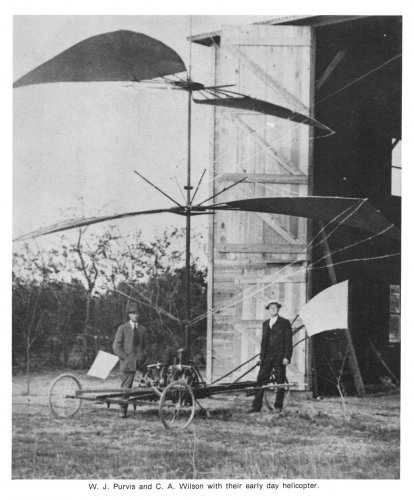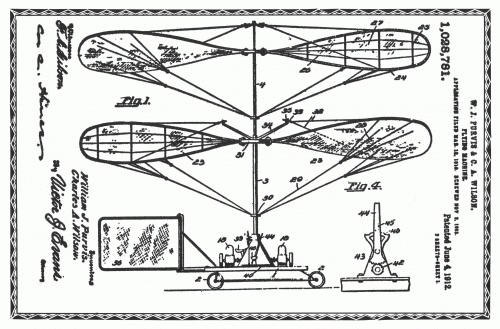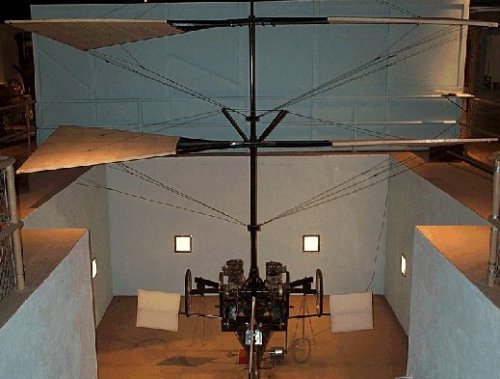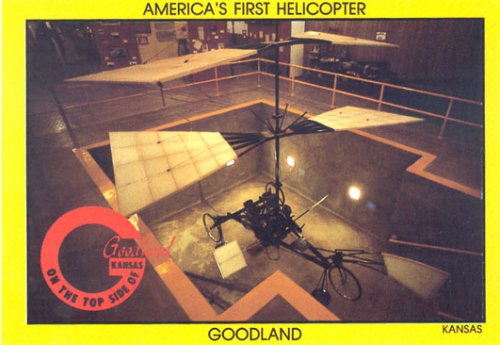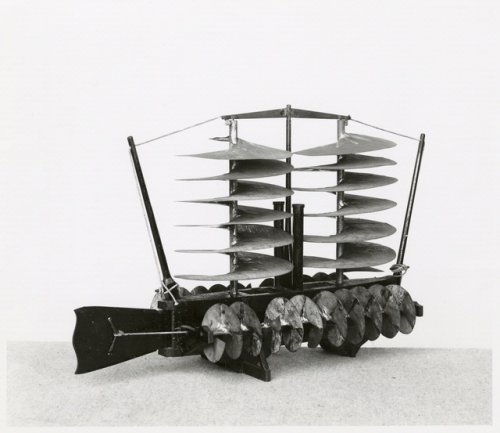- Joined
- 25 June 2009
- Messages
- 14,107
- Reaction score
- 4,239
An extract from Pioneer Airmen of Kansas by Kenneth D. Mace, published in Aviation Quarterly, Vol. 5 No. 2.
In 1909 on the high plains of western Kansas, two Goodland mechanics were bitten by the aviation bug. William J. Purvis and Charles A. Wilson built a working model of their flying machine that year, organized a stock company with $30,000 capital and made plans to build an aircraft of the "helicopter type."
The Goodland Republic reported that local residents inspected the model during a demonstration at the Purvis place just south of the railroad and west of the Rock Island yards on Thanksgiving Day in 1909.
A number of people were on hand to examine the mechanism of the machine and hear the inventors explain the working parts of the airship, the newspaper reported. Many were convinced the aircraft was practicable and novel for the transportation of passengers or making observations from the air.
The Goodland Aviation Company was granted a charter by the Kansas State Board on December 23, and active stock selling began December 31, 1909. Purpose of the company as described in the charter was the manufacture of flying machines, the sale thereof, and the purchase of real estate for the construction of shops for making airships.
Plans were submitted to the U.S. patent office and were later approved for granting a patent. The application, filed March 18, 1910, states in part:
"William Purvis and Charles Wilson have invented new and useful improvements on Flying Machines of which the following is a specification; This invention relates to flying machines of the helicopter type, the object a novel construction and arrangement of propellers and balancing and tilting planes whereby the machine may be driven upwardly or forwardly at will, supported in a stationary position in the air and controlled in its descent so that safe landings may be made.
"A further object of the invention is to provide a novel construction and arrangement and mode of mounting and bracing the propeller shafts whereby ease of operation, strength and durability are secured.
"The invention consists of the features of construction, combination and arrangement of devices hereinafter more fully described and claimed, reference being had to the accompanying drawings."
Purvis and Wilson bought "two up-to-date airship engines" of seven horsepower each that were capable of 1,500 revolutions a minute. They put up a machine shop and installed a stationary steam engine for use in building their "full-sized airship."
Money was raised by selling stock for $10 a share, the Goodland newspaper reported, and Purvis predicted the stock would go up to $100 a share.
"The device has the lifting and carrying power that no other flying machine has," the news story stated. "It can rise, remain stationary, descend, be propelled and guided."
By July 1910, the company had run into problems. The two engines were found to be of insufficient power. After tests, the inventors decided they needed at least 50-horsepower engines to get the craft off the ground.
Several successful aviators of that time used a Gnome engine in their airships, but the price was too high for the company.
Although an original, full-sized airplane was finally built, the craft never got into the air.
On March 17, 1911, the Goodland Republic reported that William Purvis had sold his home and left for the Ozarks region of Missouri. The Goodland Aviation Company held a meeting to dispose of assets including a building, original cost $400, a stationary steam engine and boiler, two 7-horsepower aeroplane engines, the original, full-sized aircraft, tools and other materials. No mention was made of Wilson.
As for the merits of Purvis's plan, the news story stated that the gyroscope propeller was a good feature, when driven at high speed, for poise in the air. Purvis insisted that the flying machine could be propelled forward by this device when tilting the propellers.
Some differed with him, the story continued, insisting that this device was all right for ascension and poise, but that it would require the adoption of the "plane and propulsion by a swiftly revolving propeller."
"Purvis rejected the idea," the story concluded, "and the scheme came to naught."
One of the engines from the original aircraft still exists. The Sherman County Bicentennial Commission sponsored the rebuilding of the airplane, using what was left of the original craft.
More on the Goodland helicopter:
http://rotorheadsrus.us/documents/488.html
http://redmalls.cms.waittinteractive.com/post/sections/kslegendsfiles/Purvis and Wilson.pdf
In 1909 on the high plains of western Kansas, two Goodland mechanics were bitten by the aviation bug. William J. Purvis and Charles A. Wilson built a working model of their flying machine that year, organized a stock company with $30,000 capital and made plans to build an aircraft of the "helicopter type."
The Goodland Republic reported that local residents inspected the model during a demonstration at the Purvis place just south of the railroad and west of the Rock Island yards on Thanksgiving Day in 1909.
A number of people were on hand to examine the mechanism of the machine and hear the inventors explain the working parts of the airship, the newspaper reported. Many were convinced the aircraft was practicable and novel for the transportation of passengers or making observations from the air.
The Goodland Aviation Company was granted a charter by the Kansas State Board on December 23, and active stock selling began December 31, 1909. Purpose of the company as described in the charter was the manufacture of flying machines, the sale thereof, and the purchase of real estate for the construction of shops for making airships.
Plans were submitted to the U.S. patent office and were later approved for granting a patent. The application, filed March 18, 1910, states in part:
"William Purvis and Charles Wilson have invented new and useful improvements on Flying Machines of which the following is a specification; This invention relates to flying machines of the helicopter type, the object a novel construction and arrangement of propellers and balancing and tilting planes whereby the machine may be driven upwardly or forwardly at will, supported in a stationary position in the air and controlled in its descent so that safe landings may be made.
"A further object of the invention is to provide a novel construction and arrangement and mode of mounting and bracing the propeller shafts whereby ease of operation, strength and durability are secured.
"The invention consists of the features of construction, combination and arrangement of devices hereinafter more fully described and claimed, reference being had to the accompanying drawings."
Purvis and Wilson bought "two up-to-date airship engines" of seven horsepower each that were capable of 1,500 revolutions a minute. They put up a machine shop and installed a stationary steam engine for use in building their "full-sized airship."
Money was raised by selling stock for $10 a share, the Goodland newspaper reported, and Purvis predicted the stock would go up to $100 a share.
"The device has the lifting and carrying power that no other flying machine has," the news story stated. "It can rise, remain stationary, descend, be propelled and guided."
By July 1910, the company had run into problems. The two engines were found to be of insufficient power. After tests, the inventors decided they needed at least 50-horsepower engines to get the craft off the ground.
Several successful aviators of that time used a Gnome engine in their airships, but the price was too high for the company.
Although an original, full-sized airplane was finally built, the craft never got into the air.
On March 17, 1911, the Goodland Republic reported that William Purvis had sold his home and left for the Ozarks region of Missouri. The Goodland Aviation Company held a meeting to dispose of assets including a building, original cost $400, a stationary steam engine and boiler, two 7-horsepower aeroplane engines, the original, full-sized aircraft, tools and other materials. No mention was made of Wilson.
As for the merits of Purvis's plan, the news story stated that the gyroscope propeller was a good feature, when driven at high speed, for poise in the air. Purvis insisted that the flying machine could be propelled forward by this device when tilting the propellers.
Some differed with him, the story continued, insisting that this device was all right for ascension and poise, but that it would require the adoption of the "plane and propulsion by a swiftly revolving propeller."
"Purvis rejected the idea," the story concluded, "and the scheme came to naught."
One of the engines from the original aircraft still exists. The Sherman County Bicentennial Commission sponsored the rebuilding of the airplane, using what was left of the original craft.
More on the Goodland helicopter:
http://rotorheadsrus.us/documents/488.html
http://redmalls.cms.waittinteractive.com/post/sections/kslegendsfiles/Purvis and Wilson.pdf

